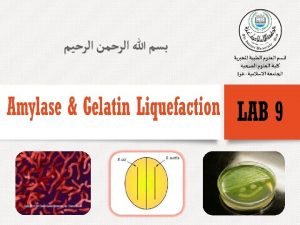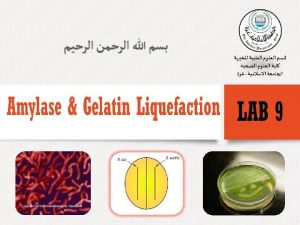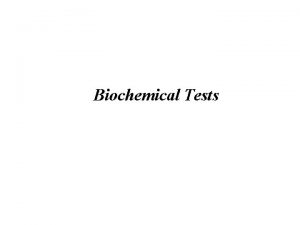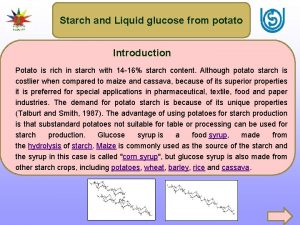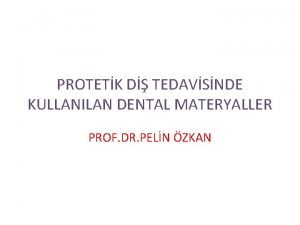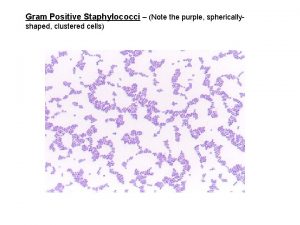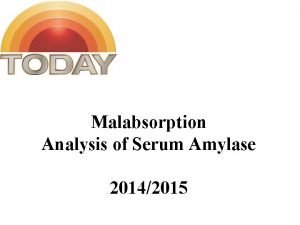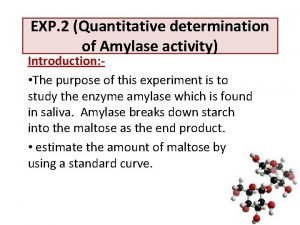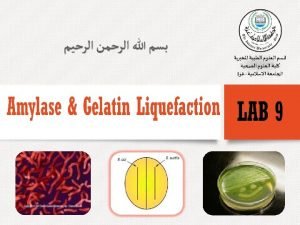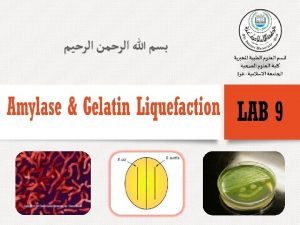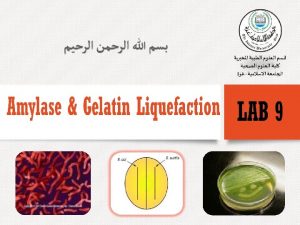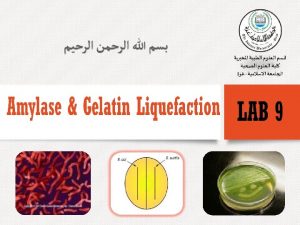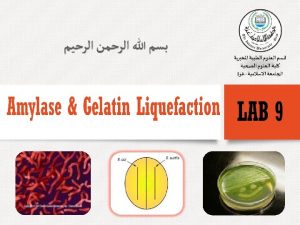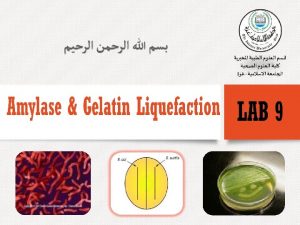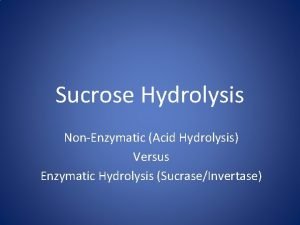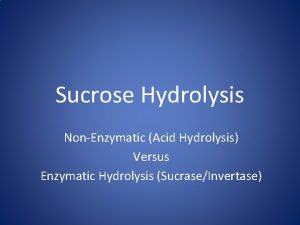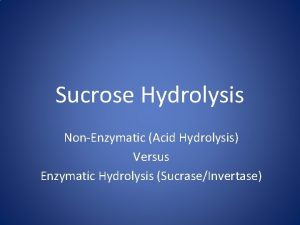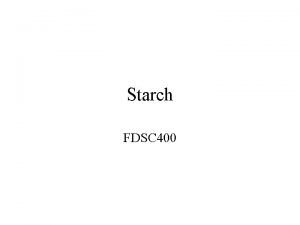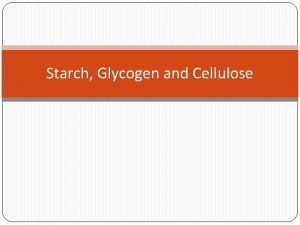Amylase Production Starch Hydrolysis Test v Starch agar















- Slides: 15


Amylase Production (Starch Hydrolysis Test) v. Starch agar is a differential medium that tests the ability of an organism to produce certain exoenzymes, including α-amylase and oligo-1, 6 -glucosidase, that hydrolyze starch. v. Starch molecules are too large to enter the bacterial cell, so some bacteria secrete exoenzymes to degrade starch into subunits that can then be utilized by the organism. v. Starch agar is a simple nutritive medium with starch added. Since no color change occurs in the medium when organisms hydrolyze starch, we add iodine to the plate after incubation. Iodine turns blue, purple, or black (depending on the concentration of iodine) in the presence of starch.

Procedure v. Streak the test organism across a small portion of the agar surface. v. Incubate at 37 o. C for 48 hours. v. Cover the surface with iodine. Rotate to distribute the iodine into a thin layer. Do not flood the plate. v. Iodine will turn blue when it reacts with starch. A clear zone will be seen where starch has been digested.

A Bacillus subtilis is on the left. Escherichia coli is on the right. B After iodine has been added, the clearing in the medium around B. subtilis demonstrates a positive result for starch hydrolysis. E. coli, with no clearing, is negative.


Gelatin Liquefaction v. Determine an organism's ability to produce proteolytic-like enzymes and liquefy gelatin. v. This test is used to differentiate Gram-negative species. Serratia, Pseudomonas, and Vibrio are positive for this test. The practicality of this test was not appreciated until, the development of the rapid procedures. v. Staphylococcus aureus, which is gelatinase positive can be differentiated from S. epidermidis(gelatinase-negative). v. Bacillus anthracis, B. cereus, and several other members of the genus are Gelatinase positive, as are Clostridium tetani and C. perfringens.


v. Gelatin is a protein derived from collagen a component of vertebrate connective tissue. v. Gelatinase comprise a family of extracellular enzymes produced and secreted by some microorganisms to hydrolyze gelatin v. Gelatin is a simple protein. § will be a solid at a temperature of 25 o. C or lower. § will be a liquid at a temperature of 26 o. C or higher. v. When bacteria that produce the enzyme gelatinase are grown in a gelatin medium, the enzyme breaks up the gelatin molecule and the medium cannot solidify even at cold temperatures. v. Two methods used to determine gelatinase production 1) The Gelatin stab method. 2) The Gelatin strip method.

The Gelatin Stab Method 1) Inoculate nutrient gelatin deep tubes (contain 12% gelatin) and incubate for up 30 days. 2) To determine whether liquefaction has occurred place the tube in the refrigerator for 30 minutes 3) Remove and check the tube for liquefaction. if negative, continue incubation until liquefaction occur. ØIf the gelatin is still intact (the bacteria did not produce gelatinase), the media will solidify in the refrigerator and a negative test result is recorded. ØIf the organism has produced sufficient gelatinase, the tube will remain liquid (at least partially) and not solidify in the refrigerator. A positive test result is recorded.

v. Some organisms may produce gelatinase in rather small quantities. Thus, a tube with a negative gelatinase result should be reincubated for 30 dys. Whenever desired, the tube may be refrigerated and results observed. If the tube is still negative after 30 days of incubation (completely solidifies when refrigerated), it can be reasonably concluded that this organism does not produce gelatinase.

The 'Serratia marcescens' on the left is positive for gelatinase production, as evidenced by the liquidation of the media. The 'Salmonella typhimurium' on the right is negative, as evidenced by the solidity of the media.

Results v. Positive strong: liquefaction occurs with 3 days v. Positive weak : liquefaction occurs in 3 -30 days v. Negative : No liquefaction after 30 days

The Gelatin Strip Method v. An alternative method for detecting gelatinase production is the use of X-ray film(Gelatin Strip) that is coated with a green gelatin emulsion. v. Organisms that produce gelatinase remove the emulsion from the strip. 1) Inoculate each of the two cultures into a separate tube of 0. 5 ml saline. The suspension should be very turbid. 2) Insert a strip of the X-ray or gelatin film into each saline suspension. 3) Incubate the tubes at 35°C. Observe at 1, 2, 3, 4, and 24 hours for removal of the gelatin emulsion from the strip with subsequent appearance of the transparent strip support

Gelatin strip test. The organism on the left does not hydrolyze gelatin and, therefore, no clearing of the gelatin film is seen. On the right, the portion of the strip submersed in the organism suspension has cleared, indicating gelatin hydrolysis.

 E coli starch hydrolysis test
E coli starch hydrolysis test Starch
Starch Starch agar test
Starch agar test Salivary amylase digestion of starch
Salivary amylase digestion of starch Starch hydrolysis
Starch hydrolysis Proses pre production
Proses pre production Liquid glucose production
Liquid glucose production Sphérification agar agar
Sphérification agar agar çinko oksit öjenol ölçü
çinko oksit öjenol ölçü Tapioca starch market
Tapioca starch market Is blood agar selective or differential
Is blood agar selective or differential Q
Q Digestion chimique
Digestion chimique Expérience amidon + eau iodée
Expérience amidon + eau iodée Quantitative determination of amylase activity
Quantitative determination of amylase activity Tiêu chuẩn atlanta 2012
Tiêu chuẩn atlanta 2012
